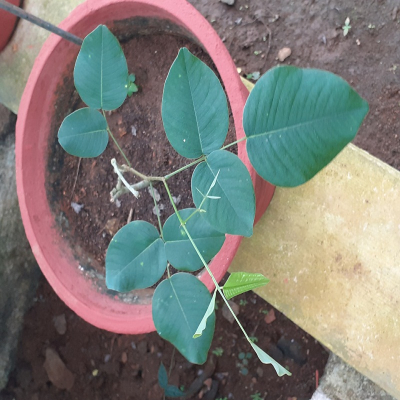Pterocarpus marsupium Roxb.
Family : Fabaceae
Group : Antidiabetic, Dyes
Parts Used : Leaf , Bark , Flower , Gum , Stem , Heartwood
Vernacular Names :-
| English | : | Indian kino tree |
| Malayalam | : | Venga |
| Hindi | : | Bijasal |
| Sanskrit | : | Asanah |
| Bengali | : | Pitasal |
| Gujarathi | : | Bibla |
| Kannada | : | Hannemara |
| Tamil | : | Veangai |
| Telungu | : | Beddagi |
Distribution and habitat: Throughout India, in deciduous and evergreen forest. Common in central and peninsular India, chiefly found in mixed deciduous forests of Gujarat and Madhya Pradesh.
Botany: A medium sized to a large tree, 15-30 m in height with dark brown or grey bark having shallow cracks, exfoliating in thin flakes and exuding a red gummy substance (gum kino) on injury.
- Leaves: Compound, imparipinnate, 15-23 cm long, rachis glabrous, leaflets 5-7 (8-13 cm), coriaceous, oblong, obtuse, emarginated or even bilobed at apex, glabrous on both surfaces, main nerves numerous, prominent.
- Flowers: Yellow in terminal panicles, about 1-5 cm in long, scented, very large. Calyx 6 mm long, veined, brown pubescent. Corolla 1.3 cm long with crisped margins. Stamens monadelphous or the staminal tube often finally slit on both sides making them isoadelphous.
- Fruits: Merely circular, glabrous, flat, winged pods, 2-5 cm in long, 5 cm in diameter, convexly curved between stipe and style, wings veined.
- Seeds: 1-2, convex bony.
Chemical constituent: Plant yields kinotannic acid, β-eudesmol, marsupol, carpusin, propterol, marsupinol and sesquiterpene alcohol.
Properties & Uses: The heartwood is astringent, bitter, acrid, cooling, anti-inflammatory, union-promoter, depurative, urinary astringent, haemostatic, revulsive, anthelmintic, constipating, anodyne, alterant and rejuvenating. Used against boils, sores, skin diseases, anorexia and fever, pyrosis, tongue diseases, locally in leucorrhoea, gleet, psoriasis, fevers, elephantiasis, gout, rheumatoid arthritis, bronchitis, greyness of hair.
Formulations: Nyagrodhadi churna, Ayaskriti, Asanabilvadi taila
Agrotechnology
Soil and climate: A soil with a fair proportions of sand, though it is often found on red loam with a certain amount of clay. Deep clayey loam to vertisol soil (black soil) with good drainage is best suited for growth and development. It thrives well under clear-cut differentiated summer and winter with medium rainfall during rainy season. It is light demander, tolerant of excessive temperature in summer.
Propagation: Seed germination is good. But seed viability and longevity is very less. Freshly collected seeds should have given water soaking for 48 hours before sowing.
Manuring: 25 kg well decomposed FYM, 200 g N and 150 g P per plant per year for three years. The nitrogen should be applied in two splits first in September and second in January.
Irrigation: Six irrigations on January, March, April, May, June and November are recommended through check basin method during the early establishment period.
Plant protection: Loss of seed viability is mainly due to the attack of seed borer insect and this can be controlled by proper drying up to 12% moisture and the use of carbon disulphide in storage.
Harvesting: Tree can be cut in 6-8 years growth for collection of heart wood.

